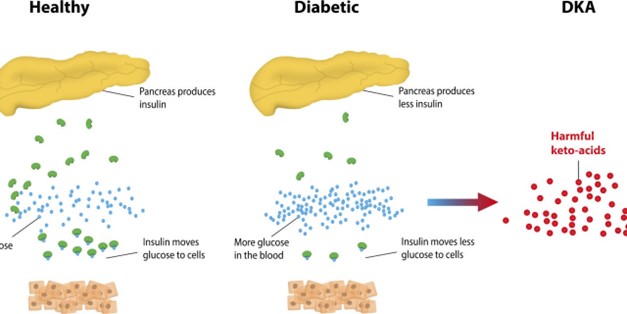A nurse is collecting data from a client who has hypoparathyroidism. Which of the following findings should the nurse expect?
Negative Chvostek’s sign
Flaccid muscles
Numbness of the hands
Hypercalcemia
The Correct Answer is C
Choice A: Negative Chvostek’s sign is the absence of facial twitching when the facial nerve is tapped. This is a normal finding and does not indicate hypoparathyroidism. A positive Chvostek’s sign is a sign of hypocalcemia, which can occur in hypoparathyroidism.
Choice B: Flaccid muscles are weak and limp muscles that lack tone and resistance. This is not a typical finding of hypoparathyroidism, as low levels of parathyroid hormone can cause muscle spasms, cramps, and tetany.
Choice C: Numbness of the hands is a common finding of hypoparathyroidism, as low levels of parathyroid hormone can cause hypocalcemia, which affects the nerve function and sensation. Numbness can also occur in the feet, lips, and tongue.
Choice D: Hypercalcemia is a high level of calcium in the blood. This is not a finding of hypoparathyroidism, as low levels of parathyroid hormone can cause hypocalcemia, which is a low level of calcium in the blood. Hypercalcemia can be a sign of hyperparathyroidism, which is the opposite condition of hypoparathyroidism.
Nursing Test Bank
Naxlex Comprehensive Predictor Exams
Related Questions
Correct Answer is B
Explanation
Choice A: Weigh the client weekly. This is incorrect because the client receiving PN should be weighed daily, not weekly, to monitor fluid balance and nutritional status. The nurse should also measure the client’s intake and output, blood glucose, electrolytes, and other laboratory values daily.
Choice B: Reduce the rate of the solution gradually to discontinue. This is correct because the nurse should taper off the PN solution slowly to prevent rebound hypoglycemia, which can occur when the high concentration of glucose in the PN solution is abruptly stopped. The nurse should follow the provider’s orders or the facility’s protocol for reducing and discontinuing PN.
Choice C: Remove solution from refrigerator 2 hr before infusion. This is incorrect because the nurse should remove the PN solution from the refrigerator 30 to 60 minutes before infusion, not 2 hr, to allow it to reach room temperature. Infusing a cold solution can cause discomfort, vasoconstriction, and impaired absorption of nutrients.
Choice D: Shake the solution before hanging if there is a layer of fat present on the top. This is incorrect because the nurse should not shake the PN solution at all, as this can cause fat emulsion droplets to coalesce and form large particles that can clog the filter or cause embolism. The nurse should gently invert or roll the PN solution container to mix it if there is any separation of components.
Correct Answer is A
Explanation
Choice A reason: A fruity odor in the breath is a symptom of hyperglycemia, especially when it is severe and causes ketoacidosis. Ketoacidosis is a condition where the body produces ketones, which are acidic substances that result from the breakdown of fat for energy when there is not enough insulin or glucose available. Ketones can make the breath smell fruity or like nail polish remover.
Choice B reason: A decreased appetite is not a symptom of hyperglycemia. On the contrary, an increased appetite or hunger is a symptom of hyperglycemia, as the body tries to compensate for the lack of glucose in the cells by stimulating the hunger center in the brain.
Choice C reason: An increased thirst is a symptom of hyperglycemia, as the body tries to flush out the excess glucose and ketones in the blood through urine. This leads to dehydration and thirst signals in the brain.
Choice D reason: A blurry vision at times is a symptom of hyperglycemia, as high blood glucose levels can cause swelling and damage to the lens of the eye, affecting its ability to focus light properly. This can lead to temporary or permanent vision problems.

Whether you are a student looking to ace your exams or a practicing nurse seeking to enhance your expertise , our nursing education contents will empower you with the confidence and competence to make a difference in the lives of patients and become a respected leader in the healthcare field.
Visit Naxlex, invest in your future and unlock endless possibilities with our unparalleled nursing education contents today
Report Wrong Answer on the Current Question
Do you disagree with the answer? If yes, what is your expected answer? Explain.
Kindly be descriptive with the issue you are facing.
